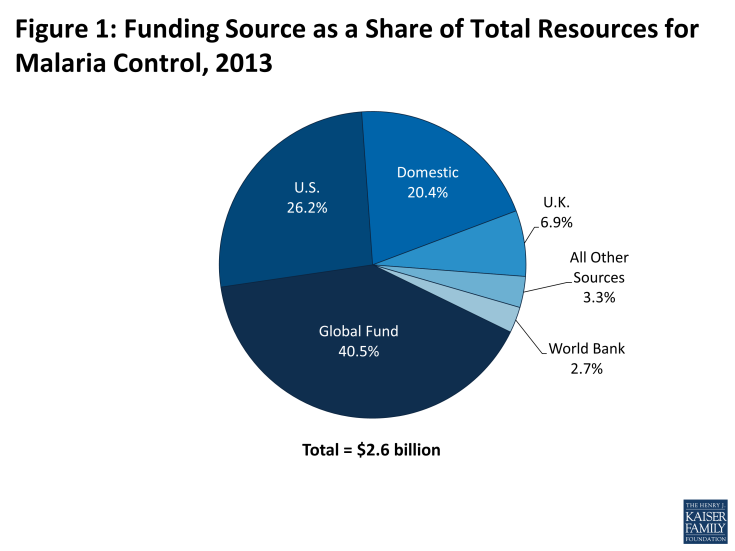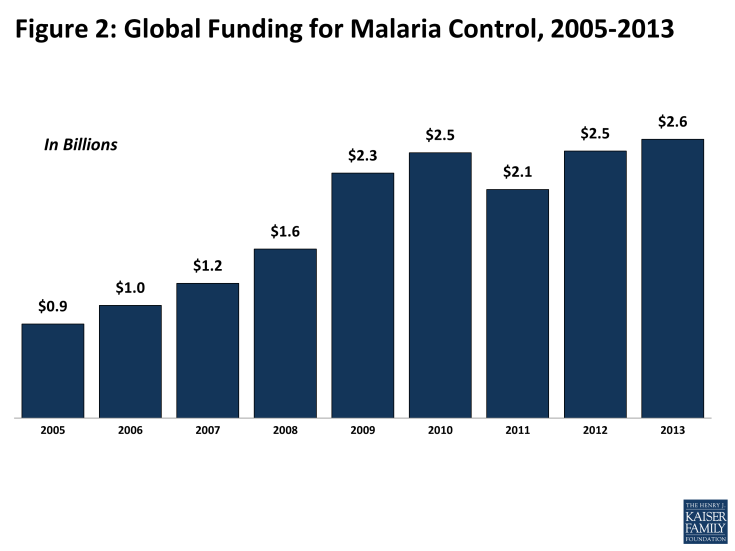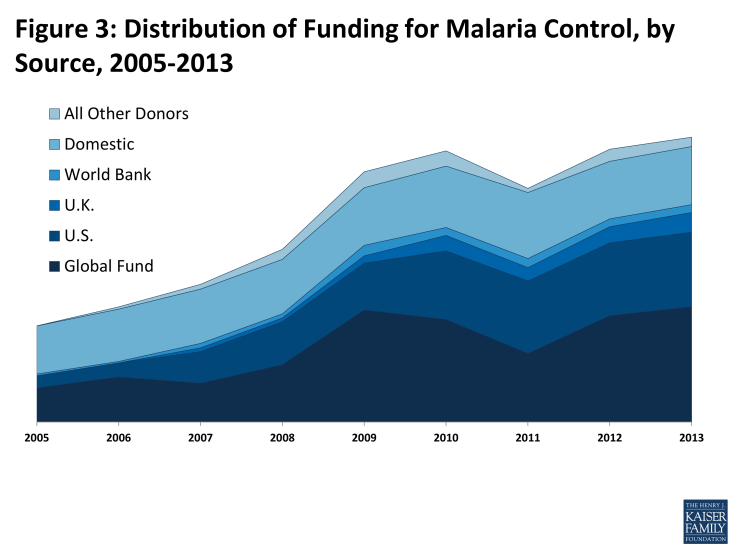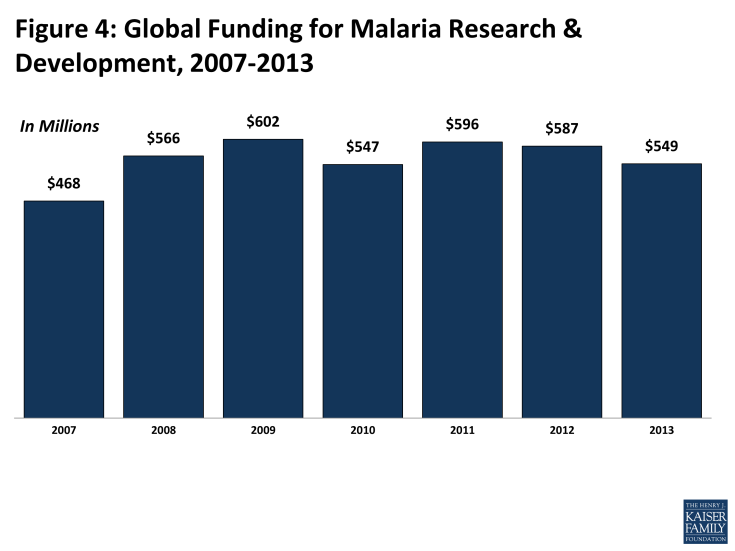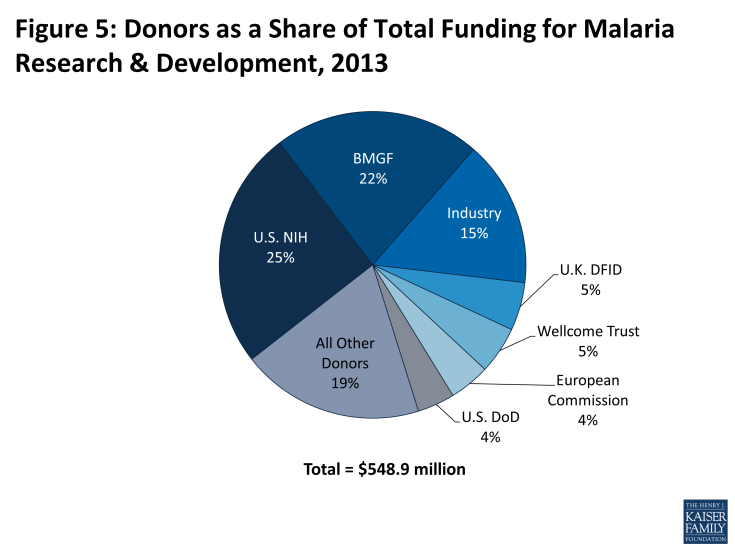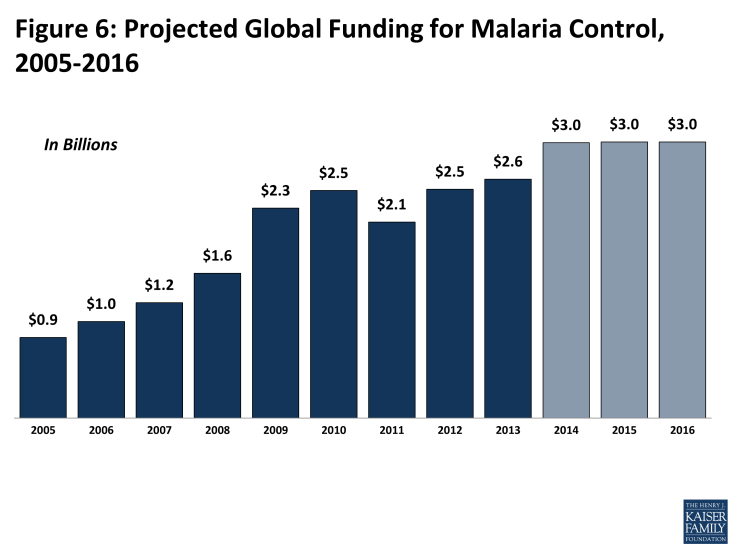Global Financing for Malaria: Trends & Future Status
Findings
Global Funding for Malaria Control & Elimination
Total funding for malaria control and elimination provided by donor governments, multilateral organizations, and domestic sources was estimated to be US$2.6 billion in 2013. Approximately two thirds of all funding for malaria control is concentrated among just two donors: the Global Fund, which is the single largest source of malaria funding, accounting for 40% (US$1.0 billion) of funding in 2013 and the U.S. (US$675 million, 26%), primarily through its bilateral President’s Malaria Initiative (PMI).1 The next largest source, domestic resources provided by malaria-affected countries, accounts for one-fifth of funding (US$527 million, 20%), followed by the U.K. (US$179 million, 7%), and the World Bank (US$71 million, 3%) (see Figure 1). Together, these five sources accounted for 97% of all funding for malaria control activities (see Box 2 for a description of funding sources).
Funding in 2013 represents an increase of more than US$100 million, or 4%, over 2012 levels. In general, funding has grown significantly over the past decade, increasing from US$871 million in 2005 to US$2,581 million in 2013, a three-fold increase. In recent years, however, increases have been much smaller: between 2005 and 2009, funding increased by US$1.39 billion, compared to an increase of US$0.31 billion between 2009 and 2013 (see Figure 2).2
Most of the growth since 2005 can be attributed to the Global Fund, first created in 2002 and which quickly has grown to become the single largest source of malaria funding in the world, and to funding from the U.S. government; the Global Fund accounted for 43% of the growth over the period and the U.S. accounted for 33%. Combined funding increases from all other sources accounted for 24% of the growth over the period. As a result, the combined share of total resources provided by the Global Fund and the U.S. has increased, rising from 48% in 2005 (35% from the Global Fund and 13% from U.S.) to 67% in 2013 (40% from the Global Fund and 26% from the U.S.) (see Figure 3).
While domestic funding demonstrated an overall increase between 2005 and 2013 (rising from US$436 million in 2005 to US$527 million in 2013), it has declined in recent years from its peak of US$598 million in 2011. Additionally, it has declined as a share of total resources from 50% in 2005 to 20% in 2013 as funding provided by the U.S. and the Global Fund has risen faster. Funding from the U.K. rose from US$35 million in 20073 to an estimated US$179 million in 2013, while funding from the World Bank grew from US$15 million in 2005 to a peak level of US$95 million in 2009 and has since declined to an estimated US$71 million in 2013.
Global Funding for Malaria R&D
According to data from Policy Cures, total funding for malaria research and development activities in 2013 was estimated to be US$549 million, a decrease of US$38 million compared to 2012 levels (US$587 million) and was at its lowest level of funding since 2010 (see Figure 4).4
The NIH accounted for the largest share (25%) of malaria research and development funding in 2013, followed by the Gates Foundation (22%) [the Gates Foundation also provides other funding for malaria (see Box 3)]. The third largest source of funding for malaria R&D is the pharmaceutical and biotechnology industry (15%), followed by DFID (5%), and the Wellcome Trust (5%), a charitable organization in the U.K. that supports biomedical research and the medical humanities (see Figure 5).
|
Box 3: The Bill & Melinda Gates Foundation
|
|
The Gates Foundation, founded in 2000, has grown to become a major funder of global health efforts and provides significant resources to support malaria control and eradication as well as R&D. We obtained data directly from the Foundation to estimate its total funding for malaria over time.
Note: Gates Foundation data include funding for both malaria control and elimination and R&D activities (due to differences in reporting methodologies, the data presented here should not be used in conjunction with G-FINDER data to estimate Gates Foundation contributions to malaria control activities). Data do not include the Foundation’s contributions to the Global Fund which may in turn be used for malaria activities. See Methodology for additional information.
–
Sources: Analysis of data provided by the Gates Foundation; Bill & Melinda Gates Foundation, Gates Foundation Commits More than $500 Million to Tackle The Burden of Infectious Disease in Developing Countries, November 2014.
|
Global Funding Gap & Looking Ahead
Despite significant increases over the past decade, total funding for malaria control activities in 2013 was significantly below the GMAP’s estimated annual need of US$5.1 billion. Similarly, support for malaria R&D programs was also below the estimated annual need (US$750-900 million).5
While future funding levels for malaria control activities beyond 2013 are not yet known for all funding sources, projected data are available from the U.S. and the Global Fund, the two largest funders of malaria efforts. Both are projected to increase their funding in the next several years. The Global Fund has already allocated approximately US$4.3 billion for malaria in the period between 2014 and 2016 (US$1.4 billion annually), which would be a nearly US$400 million increase above 2013 levels.6 U.S. bilateral funding is projected to increase to US$693 million in 2014 (an $18 million increase), and US$701 in 2015 (an $8 million increase above 2014 levels).7 Based on these increases, and assuming funding from all other sources remains flat, total funding for malaria control would rise to US$3.0 billion in each year between 2014 and 2016 (see Figure 6). This would still leave a gap of US$2.1 billion. In fact, even if all other donors doubled their funding for malaria, there would still be a gap.
While projected funding levels are not available for malaria R&D activities, if the funding declines of the past two years continue, the gap between estimated need and available resources will increase.
Separately, in its 2014 World Malaria Report, WHO has made future projections of malaria funding under two longer-term funding scenarios for 2020.8 The first scenario projects what would happen if malaria funding increased at the same rate as overall government expenditures are projected to increase. The second scenario adds to the first by projecting additional gains that would occur if donor governments met the official development assistance (ODA) target of 0.7% of Gross National Income, a global target first pledged by the United Nations General Assembly in 1970 and reaffirmed at subsequent international meetings.9 Despite these scenarios leading to increased funding for malaria, neither reaches the $5.1 billion estimated need. Scenario 1 results in a total funding estimate of US$3.8 billion in 2020 and Scenario 2 results in US$4.3 billion.

